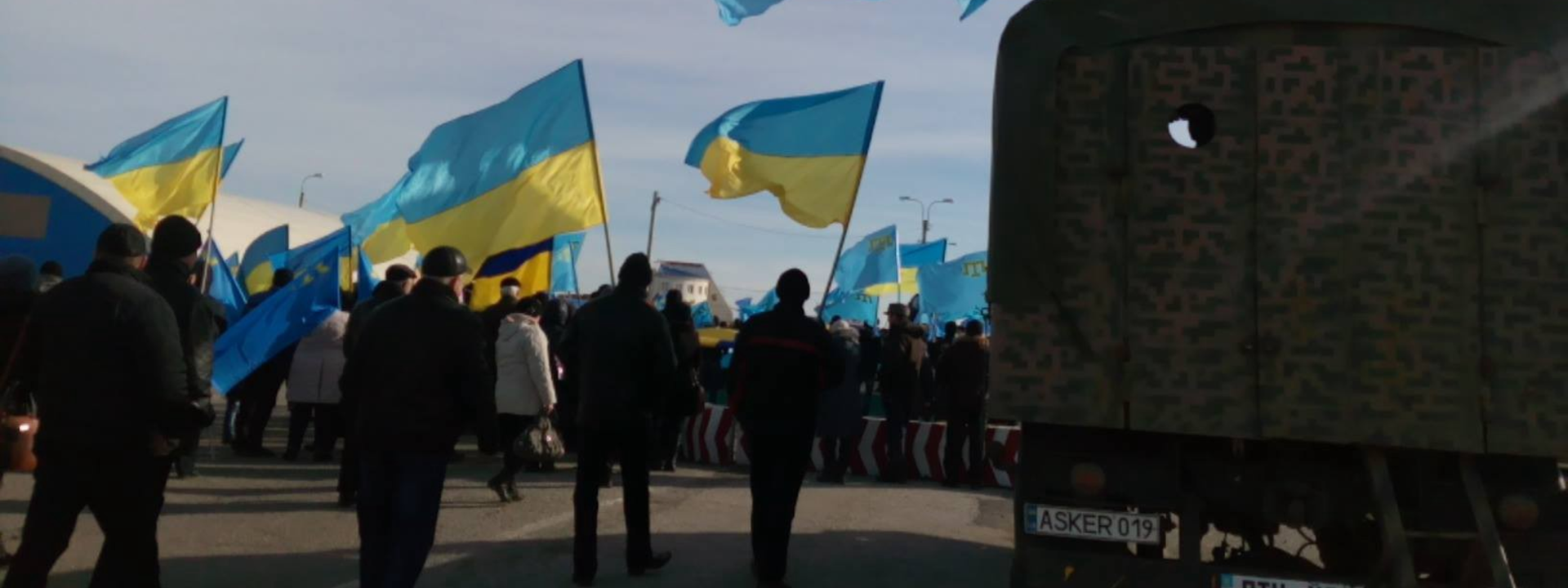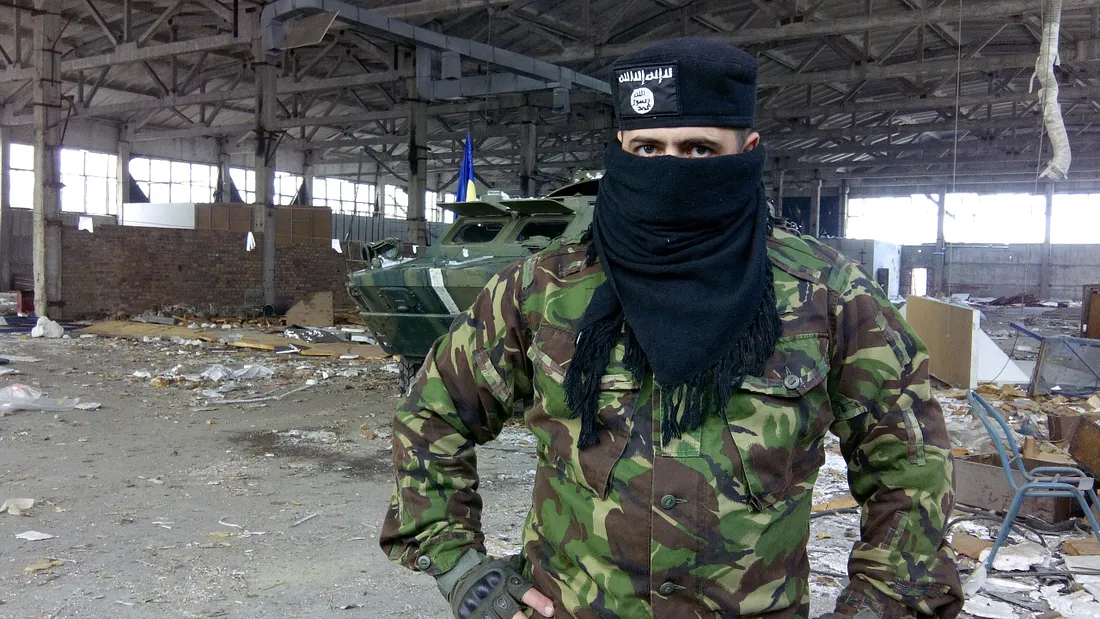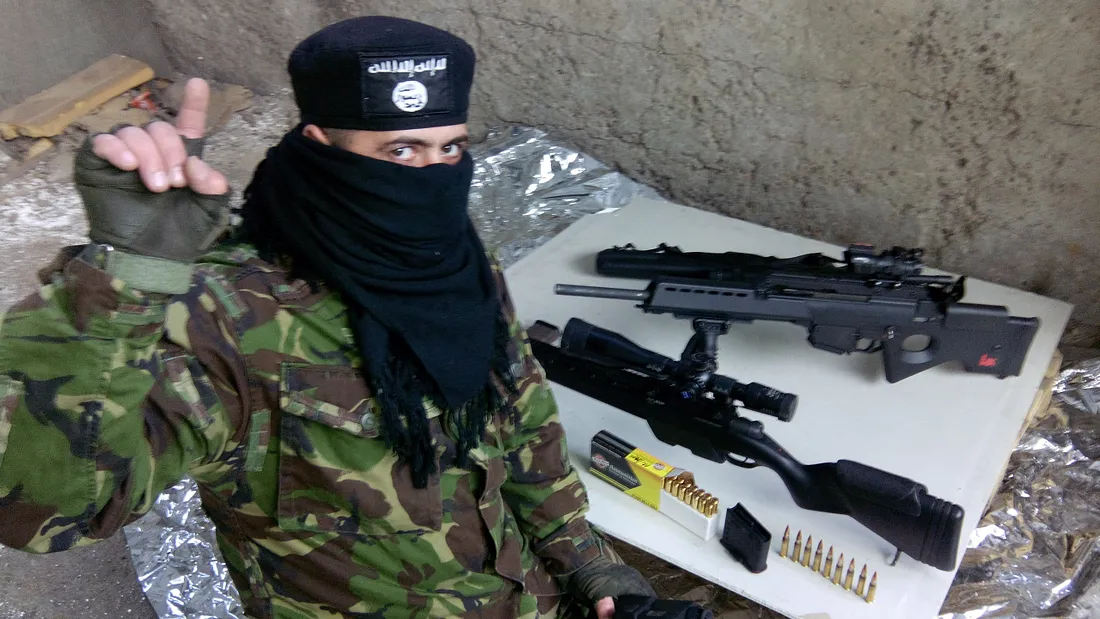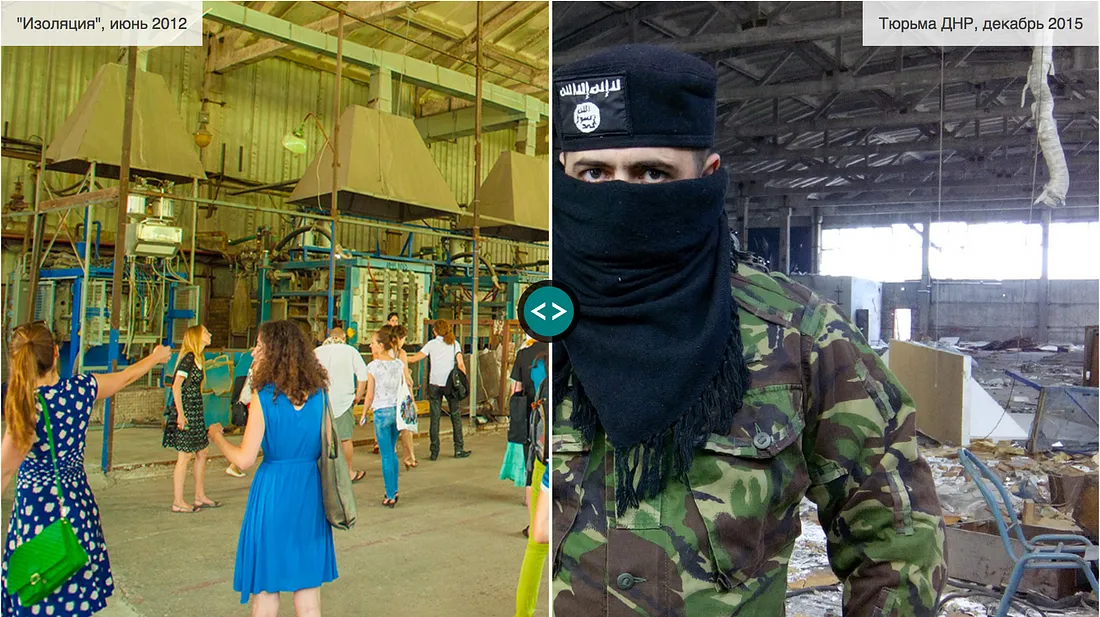Fake “Islamic Battalion” Arrives in Mariupol
Citing intelligence reports, separatist official deploys Islamophobia in baseless claims
Fake “Islamic Battalion” Arrives in Mariupol
Share this story

BANNER: Members of the Asker Battalion and “Civil Blockade of Crimea” at a checkpoint into Russian-occupied Crimea. Photograph uploaded on February 26, 2017. Source: Facebook page of “Civil Blockade of Crimea.”
On April 8, the spokesperson of the self-proclaimed Donetsk People’s Republic’s Ministry of Defense, Eduard Basurin, made an extraordinary claim: an “Islamic brigade” with as many as 500 fighters had been deployed to the Ukrainian port city of Mariupol and was working with the 36th Naval Infantry Brigade.
Even more shocking, according to Basurin, they had taken control of Mariupol’s port and were facilitating the illegal trafficking of chemical weapons to unidentified Middle Eastern countries.
“We have discovered the arrival of an Islamic battalion with as many as 500 people in Mariupol. This battalion will be operating in the zone of responsibility of [Ukraine’s] 36th Separate Naval Infantry Brigade. The battalion is tasked with security over warehouses of rocket-artillery weapons, and also taking control of Mariupol port, which has become a transit point for the illegal arms trade, including chemical weapons, with countries of the Middle East. The battalion is deployed on Bakhchivandzhi Street. The handler of the battalion is a commander of a company of the Ukrainian National Guard, Major Karpenko.” — Eduard Basurin (April 8, 2017)
What exactly is Basurin talking about with this “Islamic battalion,” and is there even a grain of truth to these extraordinary claims?
Local reaction
Most locals in Mariupol reacted to the announcement with tears — but tears of laughter, not fear. On one local VK group, the first three replies to a post on Basurin’s comments were: “Oh, ridiculous,” “Oh daaaaaaang, how can I even leave the house now?” and a comment making fun of the idea of a “Major Karpenko” — with a very Ukrainian-sounding name — becoming the commander of this so-called Islamic battalion.
Later on in the comment thread, a few users showed up to defend the validity of the idea that an Islamic battalion could have suddenly appeared in their city.
Basurin’s statement made two main claims, one specific, the other general. The specific claim was the stationing of an “Islamic battalion” on a named street in Mariupol; the general claim was that of chemical weapons trading.
The specific claim quickly provoked skepticism. Some Mariupol locals started wondering about the logistics as presented by Basurin: where is there a base on Bakhchivandzhi Street big enough for 500 people to move in and start working?

There is indeed a base for military unit 3057 on Bakhchivandzhi street, though it is difficult to imagine that an additional 500 people could be based out of this location.

No locals mentioned anything about roaming groups from this so-called Islamic battalion on any of the major, public Vkontakte groups, as one would expect following the separatist official’s statement. Given the lack of evidence, and the lack of sufficient facilities to host such a large unit, Basurin’s specific claim appears to be a fake. So, where did he get the story from?
Origins of a fake
Like most fakes, Basurin’s story of a 500-person Islamic battalion working with the naval infantry brigade in Mariupol is a false claim launched from a small grain of truth. In February 2017, Mustafa Dzhemilev, a Ukrainian MP and widely-recognized leader of the Crimean Tatars, said that there was an agreement in place with the Ukrainian Ministry of Defense to create a naval infantry unit from the 250-man Asker Battalion, a controversial Crimean Tatar volunteer group.
The Asker Battalion has drawn criticism from both Russian and Ukrainian society for its role in disrupting life in Crimea and the Ukrainian-controlled area near the border after the peninsula was illegally annexed by Russia. Since its formation in 2016, this group of Crimean Tatar volunteers has organized a blockade along the Crimean border and been involved in conflicts with Ukrainian police.

Despite the February announcement, on April 8, Lenur Islyamov, a Crimean businessman and organizer of the Civil Blockade of Crimea, said that the Asker Battalion had still not been integrated into the Ukrainian naval infantry forces.
“The reason for the delay is the rigidity of some of the military officials who make such decisions. Even today they believe negative myths about Crimean Tatars. (…) Unlike some Ukrainian politicians and military officials, I think that it is very much necessary to create a military unit within the Ukrainian ranks where there is the possibility to recognize the basic needs relating to soldiers’ religious symbols.” -Lenur Islyamov, April 8, 2017.
While Basurin never explicitly referred to Crimean Tatars or the Asker Battalion, it seems quite likely that he was alluding to the Asker Battalion working with the 36th Naval Infantry Brigade, currently deployed in and near Mariupol. However, for some reason, Basurin doubled the expected size of the yet-to-be-formed unit in the naval infantry brigade, from the Asker Battalion’s estimated 250 to 500 volunteers.
While Basurin’s claim is unequivocally false, the grain of truth lies in the plans — though apparently now on hold — to integrate a volunteer battalion with majority-Muslim (Crimean Tatar) membership into the ranks of the Ukrainian naval infantry. The remaining details, however, are pure fiction: the size of the battalion, the status of the yet-to-be integrated volunteer group, and the location of the “500” new fighters.
A history of Islamophobia
This is not the first case of fake news connecting groups of Muslims and jihadists to the Ukrainian military and the volunteer battalions working with it. The most famous example came in early 2016. In this instance, the ostensibly independent hacking group Cyber Berkut “leaked” a series of photographs supposedly taken from a fighter of the notorious Azov Battalion. There are a myriad of legitimate reasons to criticize this far-right volunteer group, especially before its integration into the Ukrainian National Guard: the OSCE and United Nations Higher Commissioner of Human Rights have documented incidents of torture performed by the group. However, Cyber Berkut still fabricated evidence showing Azov fighters wearing clothes with ISIS symbols.


However, these photographs were not shot at an Azov Battalion base, but instead in an abandoned art center in Donetsk, the heart of separatist-held territory. In an exhaustive investigation, the BBC Russian Service’s Andrey Soshnikov geolocated these photographs and uncovered the “art of the fake,” describing how the art center in Donetsk became an “ISIS base.”



Clearly, the Cyber Berkut story of an ISIS-Azov hybrid group was a pure fabrication. However, we can observe how other stories — like the “Islamic battalion” of Mariupol — start with a grain of truth, and grow into grand conspiracies rooted in Islamophobia.
For example, in 2015, multiple well-researched reports, including from the New York Times and Intercept, described how primarily-Muslim volunteer groups, some with links to extremist organizations, participated in fighting in the Donbas. In turn, ultra-nationalist websites published stories with headlines without any basis in reality, such as “Kiev Junta Supplying Weapons To Terrorist Group ISIS/GL!”, “ISIS Training Camps Concentrated in Southern Ukraine,” and “Ukraine Imports ISIS Oil through Odessa Port”.
Conclusion
Basurin’s claim of the arrival of an “Islamic battalion” has little basis in reality, and likely arose out of an exaggeration of the halted integration of a volunteer group of Crimean Tatars into the ranks of the Ukrainian naval infantry. This separatist claim is not an isolated example of Islamophobia, as we have seen with previous examples from ultra-nationalist and pro-separatist news outlets.
The unsubstantiated general claim of chemical weapons trafficking is even less convincing, resting solely on Basurin’s word. Nonetheless, it is perhaps more interesting in light of the American airstrike against Syria resulting from the use of chemical weapons in Khan Sheikhoun.
The “Middle Eastern countries” to which Ukraine is allegedly exporting chemicals weapons were not named, and the narrative may have implied connections to the initial Russian argument that the opposition groups attacked in Idlib province were in possession of chemical weapons. The DFRLab will continue to monitor this claim and its use in further reporting in Russian-language media.

